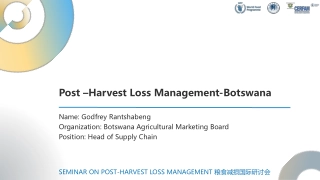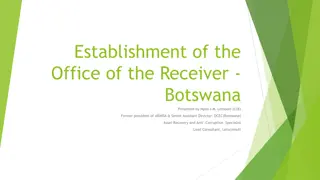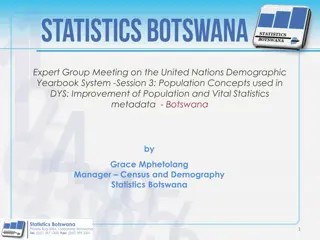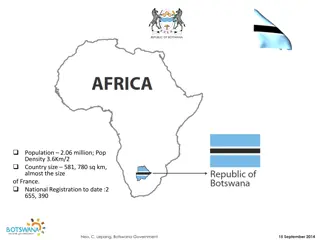
Quarterly National Accounts Compilation in Botswana by Lekoko Simako
"Learn about the framework, classifications, challenges, and production approach of Quarterly National Accounts in Botswana, following the principles of the System of National Accounts. Explore the importance of timely production and the need for revisions in this economic data compilation process."
Download Presentation

Please find below an Image/Link to download the presentation.
The content on the website is provided AS IS for your information and personal use only. It may not be sold, licensed, or shared on other websites without obtaining consent from the author. If you encounter any issues during the download, it is possible that the publisher has removed the file from their server.
You are allowed to download the files provided on this website for personal or commercial use, subject to the condition that they are used lawfully. All files are the property of their respective owners.
The content on the website is provided AS IS for your information and personal use only. It may not be sold, licensed, or shared on other websites without obtaining consent from the author.
E N D
Presentation Transcript
COMPILATION OF QUARTERLY NATIONAL ACCOUNTS BOTSWANA BY Lekoko Simako
CONTENTS Background Compilation Framework Classifications GDP by production approach Data Sources by Economic Activity Revisions Challenges Way Forward
Background QNA adopt the same principles, definitions, and structure as the annual national accounts (ANA). In the initial stage of implementation, only estimates of gross domestic product (GDP) by production side can be derived. Extensions can be made as the use of the system becomes more established
Contd. Quarterly accounts have to be produced in a very short period of time Quarterly National Accounts are published 90 days after reference quarter. They cannot be as comprehensive as annual accounts with full articulation of institutional sectors.
Background Rely on roughly estimated data and therefore need to be more frequently revised as more reliable data come into streams Benchmark QNA to annual accounts Quarterly account data needs to be seasonally adjusted
Compilation Framework System of National Accounts (SNA) is used as a framework (1993) SNA designed to apply to countries at any stage of development. Crucial to understand the principles of the SNA and then apply them in light of local circumstances. IMF Quarterly National Accounts Manual
Classifications The SNA uses several classifications International Standard Industrial Classification of All Economic Activities (ISIC) is the international reference classification for productive activities Classification of individual Consumption According to Purpose (COICOP) Classification of the function of Government (COFOG) HS: Foreign Trade
Production approach GDP by the production approach is assumed more reliable It is also called the output approach, measures GDP as the difference between the value of output less the value of goods and services used in producing these outputs during an accounting period
Main sources from the Statistical Office Short-term surveys by economic activity Sales/Turnover (output) and on prices Consumer prices Production prices Export and import prices
Main administrative sources Tax information Government data on revenues and expenditures Financial intermediation and insurance companies Information from large corporations (Mining, Water, Electricity, Communications, Transportation etc Exports and Imports of goods and services
Sources by Activity: AGRICULTURE Quarterly indicators: values/quantities Ministry of agriculture - Actual harvest data (crops, Horticulture) -Forecasts, especially for most recent quarters Surveys (farmers, marketers) Marketing organizations (BAMB) Livestock population Animal slaughter statistics
MINING Quarterly indicators: values/quantities Quarterly sales and inventory figures Administrative data (production statistics) Exports data PPI components/specific purpose price indices
MANUFACTURING Quarterly indicators: values/quantities Surveys: Quantity data Sales figures VAT data (on sales) Export data (eg. Meat products, textiles, polished diamonds etc..) PPI components
Water and Electricity Quarterly indicators: values/quantities Quarterly sales figures Admin records Physical quantity from large utility companies or authorities Electricity generation/consumption water supplied Consumption of inputs PPI components/specific tariffs
Construction Quarterly indicators: values/quantities Building permits (administrative register) Surveys: - Construction companies Input indicators (supply of building materials) Government budget for public construction Road construction, Dams
Wholesale and Retail Trade Surveys of retail and wholesale trade VAT data CPI components
Transportation and Storage Quarterly indicators: values/quantities Surveys : revenue/quantities (passengers or freight Information from large enterprises (airlines, airports, rail, public transportation) Freight: volume of goods handled PPI/CPI components
Accommodation and Service Activities Quarterly indicators: values/quantities Accommodation Survey (Turnover, COE and Employment) - DOT Tourists arrivals CPI components
Financial and Insurance Activities Quarterly indicators: values/quantities Money and banking statistics Stocks of deposits and loans, interest receivable and payable by institutional sector (for FISIM calculation) Life insurance (premiums and claims) Non-life insurance (premiums and benefits) Deflation (on deposits and lending, but not on FISIM directly)
Real Estate Activities Quarterly indicators: values/quantities Surveys VAT data Dwelling rents Stock of dwellings (own-account) Housing price/rates
Public administration; Defence; Social Security Quarterly indicators: values/quantities Government finance statistics Employment Wage index
EDUCATION Quarterly indicators: values/quantities Government finance statistics Survey (Private Education) Quantity indicators from public/private school (number of pupils enrolled, teaching staff number) Wage index/CPI
Human health and social work activities Quarterly indicators: values/quantities Government finance statistics Survey (Private hospital Wage index/CPI
Taxes on products/Subsidies Taxes on imports Value Added Tax Ministry of Finance Values and volumes of imports (preferably with breakdown by type of product)
Revisions Revisions are an essential part of good quarterly national accounts (QNA) because they provide users with data that are as timely and accurate as possible. Good management of the process of revisions requires the existence of a well-established and transparent revision policy. First estimates are normally based on limited or unaudited data and hence cannot be precise and absolute. The figures are revised after receiving finalized or audited data from companies compilation practice
Revisions contd. Quarterly Estimates should be benchmarked to Annual Estimates. Excel Procedure for Bench Marking (XLPBM)is used.
TRAINING Every year National Accountants are invited for different training platforms either by IMF, Afritac South, SADC, MFEMI, AfDB, COMESA. Benchmark to other countries with well established QNA
Challenges Obtaining access Different classifications Timeliness
Way forward Implementation of SNA 2008 Compilation of Supply and Use Table (SUT) Rebasing
END THANK YOU






















